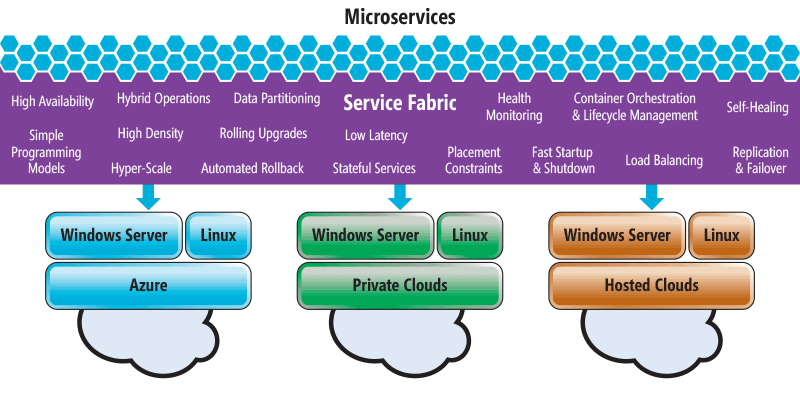Microservices using Azure
In the present day, internet scale services are put together by means of Microservices. And, a lot of instances of Microservices which are available are user profiles, shopping carts, inventory processing, queues etc. They are versioned, scaled, and set up individually and can be resolved easily. In case of failures also they keep on logically reliable. Accommodated in a container, they can be written in any language or framework. With all these benefits in the offing, they have turned out to be a prevalent architectural style for building cloud applications. It is not a mere buzzword, as Microservices call for a diverse method to designing and building applications. And the built applications are strong, highly accessible, and are able to evolve rapidly.
As software developers, there is nothing different in what way we contemplate about factoring an application into component chunks. But one thing which is pretty visible is that all the software developers are constructing distributed applications that are for the cloud and are motivated by the business. However, with the varying business requirements every now and then, the building of applications is also getting affected. Normally, the varying business requirements which occur in this ever-changing computer era can be summed up as follows:
- A service that is put up and functions at scale to influence clienteles in new geographical areas.
- Quicker supply of types and competences to be able to answer back to client burdens in a responsive mode.
- Better-quality resource deployment to decrease budgets is also one of the requirements.
Begin small, measure when required, deplore services, increase new ones, and go forward with client norm must be the line of attack to yield benefits. Before moving ahead, let us understand the term Microservices in a comprehensive manner and the reason of using it, characteristics and the various benefits that it offers.
What are Microservices?
From the stand point of a novice, it is similar to a large container in which all the software components of an application are gathered together and closely wrapped. It is an architectural style that structures an application as a group of minor autonomous services, demonstrated around an industry area. In Microservices architecture, when applications are destroyed into reduced portions that work together, are easier to construct and sustain. The USP of Microservices is that each component can be organized, pulled off or redeployed without disturbing the application’s consistency.

Without a shred of doubt, we are in the middle of an application development and IT system management uprising focussed on the cloud. Firm, agile, cheap, and hugely scalable infrastructure, is refining operational productivity and allowing faster time to assessment across businesses. The advent of containers, with their fast start-up, standardized application packaging, is further contributing to proficiency and swiftness. On the other hand, a lot of companies are discovering that building their applications extremely available, scalable and agile is still daunting. Competitive industry stresses demand a constant evolvement of applications, adding of the new features and functionality while remaining accessible 24×7.
This can be understood with the help of an instance, if an e-commerce site is down for few minutes driving their prospective clienteles to their counterparts that can help them at that point in time. Let-down to come across these hassles can mean the variance between remaining relevant and dropping business. All these instances or business truths are motivating developers to take on an application architecture model called Microservices. Microservices architecture can aid with application development and lifecycle jobs, and define the competences that platforms can offer to support those architectures.
Some characteristics of Microservices highlighted, which will help you while you are constructing applications by means of this type of framework. They are:
Here, in this architecture, each component is established independently, and the resulting application is then just the sum of its basic constituents. Fulfilling a single business capability, each service is self-contained in Microservice architecture.
Also, each service runs a single procedure and generally manages its individual database. This way the task becomes much easier and each service can be deployed, reconstructed, redeployed and managed individually. Microservice, being small can be easily maintained by a single developer. They can be executed by means of diverse programming languages, databases, and software setting. Each service is flexible, strong, minimal, and widespread. Deployment and reorganization of each Microservice can be done individually of other services. Comprising of separate code bases, they do not share source code.
Benefits
If they are deployed that way they should be, they offer a myriad of benefits. They are as follows:
- In the first place, it offers agility. Case in point, as Microservices are set up individually, it is pretty easy to bring about bug repairs and feature releases. An individual service can be updated minus reorganizing the complete application. However, if it is done in a traditional way then, it can block the complete release procedure. As a result, the bug fixes cannot be updated and released.
- As the software put together by means of Microservices can be broken down into several component services, each of these services can be organized and then redeployed individually devoid of bargaining the integrity of an application. In Microservice architecture, services can be deployed and developed independently.
- Since the code base is small, it is understood well by the software developers complementing cloud activities.
- The code can be written in various languages as per the need.
- With easy integration and automatic deployment, the Microservice architecture enables continuous delivery.
- Easy to understand, scalable, reusable and can be integrated very easily with other services.
- The various components used in Microservice architecture can be spread across multiple servers.
- Last but definitely not the least, it upsurges the independence of separate development teams in an organization, as thoughts can be applied and set up without having to synchronize with a comprehensive IT delivery task.
Some downsides explained
However, with so many benefits, it has some downsides too. Here is a list of some prospective pain zones linked with Microservices projects:
- First and foremost, developing distributed systems can be difficult. As each service module is an autonomous service, the requests traveling between your modules must be handled carefully to avoid disruption.
- Using numerous databases and transaction management can be daunting.
- Analysing a Microservices-based application can be burdensome, as each dependent service requires to be established before testing.
- Also, the deployment of a Microservices can be a little difficult.
These issues must be explored so as to get the best results before the deployment by adopting the best practices.
Conclusion
The computing domain has transformed continually with the arrival of the cloud. Cloud offers a lot of benefits such as: developers have an access to infrastructure promptly, economically, and at practically countless measures. The swiftness of cloud and high accessibility and continuous swiftness demands of current industry have stressed monolithic architectures and resulted in the increase of Microservices-based applications. By means of a complete Microservices platform, software designers can build applications that support huge scale with great performance, high accessibility, cost efficiency, through public clouds and private clouds.
Microservices are an application revolution driven by the cloud. A lot of companies have begun to build for the cloud for business ins and outs, as the firms have understood the profits of taking a microservice-like method. This is because all of them found that there were stiff difficulties to resolve outside of their main areas of forte. For this very reason, service fabric developed grip as the technology of selection for building services. On the other hand, we all are aware of the simple fact that there are several new difficulties yet to be explained to make Microservices more open for maximum software designers. Looking forward we are pretty sure that more inventions will arise to make this easier.




